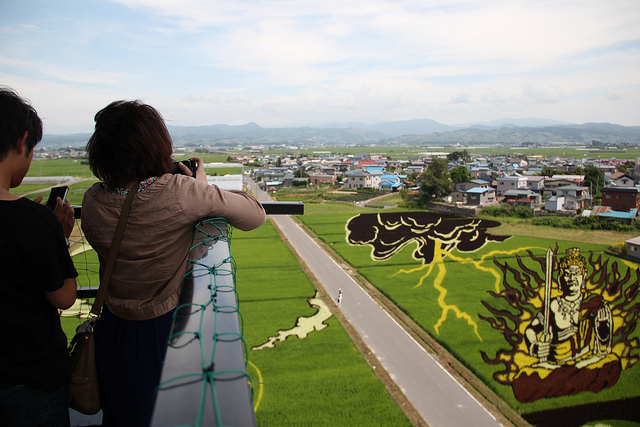
photo by Shinya ICHINOHE
Inakadate in Aomori prefecture is a little quiet village with a population of only 8000 most of the time. But about 300,000 tourists pour in this little village during summer time. What for they come here is rice paddy arts, which are elaborate designs on the rice paddy fields by intermixing a variety of rice strains to create large scale artworks. It started as a small scale attempt to revitalize the village, however, rice paddy arts attracts hot attentions from all over the world including Japan itself. This column will explore the beauty of rice paddy arts. The picture above is “oiran” from 2013 artworks.
What is rice paddy art?
Originally, people in Inakadate in Aomori, which has a long history of rice farming, started holding a rice planting tour for children in 1993 to invigorate their village. This is the beginning of rice paddy art. It started with just a simple design with a few words and a picture of the local hill. But the designs have become more and more artistic over the year by utilizing a survey system and perspective drawing methods to create more elaborate images. It started attracting lots of attentions from all over the country since it had been introduced on a TV show. Now a huge number of tourists visit this village from inside and outside of Japan. The pictures are colored by hand planted rice strains. Instead of artificially colored rice seedlings, people in Inakadate use a range of different types of rice plant which grow in many different colors to create colors and gradations. Rice paddy art has started spreading to other parts of Japan. The artworks in other towns are astonishing tourists and as unique and high-quality finished as ones in Inakadate.
2015 Rice Paddy Art
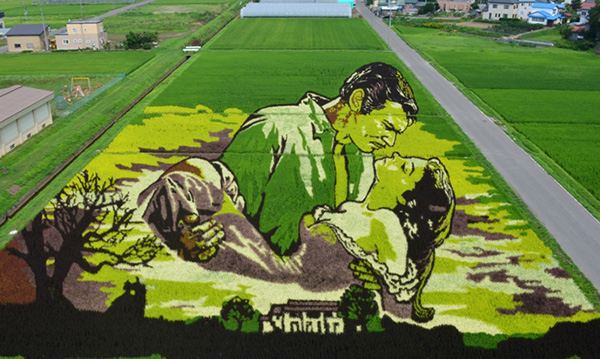
photo by Manisha Kundu-Nagata
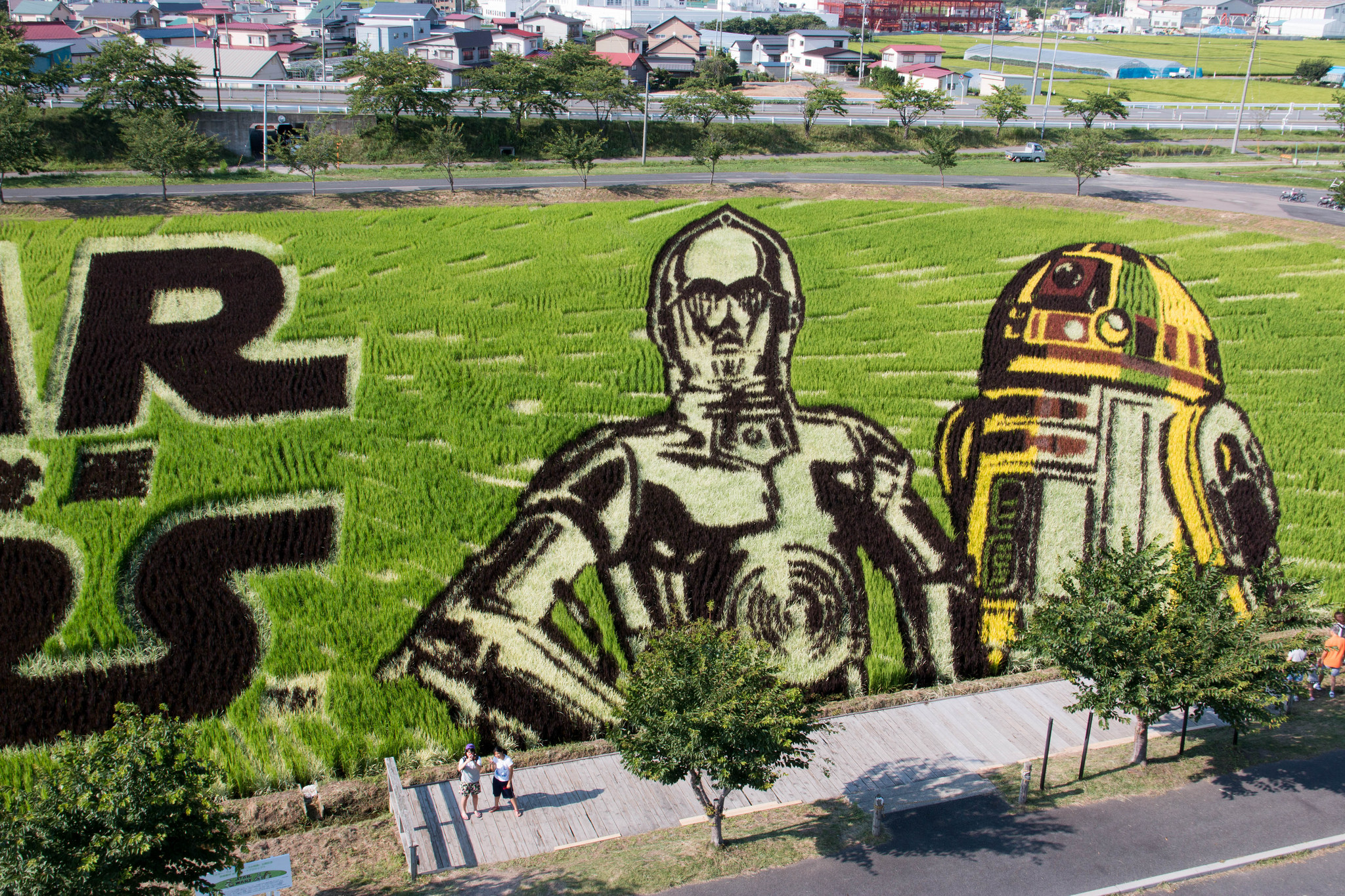
photo by yari hotaka
The 2015 rice paddy arts were created under the theme of “Gone with the Wind” and “Star Wars the Force Awakens”. A scene from “Gone with the Wind” was recreated in the picture of Rhett Butler (played by Clark Gable) holding Scarlett O’Hara (played by Vivien Leigh). The “Star Wars” picture, on the other hand, was design-edited by Lucasfilm to beautifully portray everyone’s favorite C3-PO, R2-D2, and 2015 new character BB-8. On July 22nd 2016, four of storm troopers surprised the audiences by turning up during the migoro (the best time) declaration.
Previous year’s rice paddy arts
These are some examples of rice paddy arts in Inakadate in previous years.

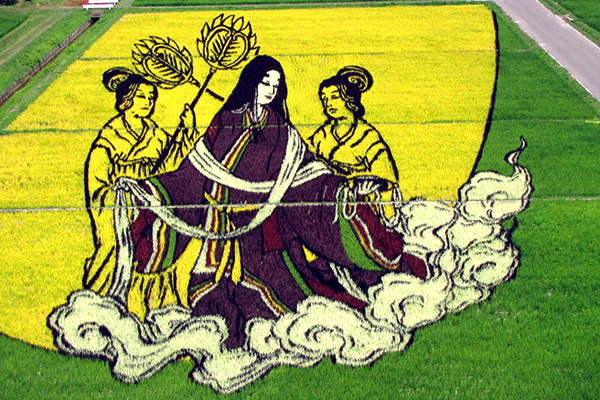
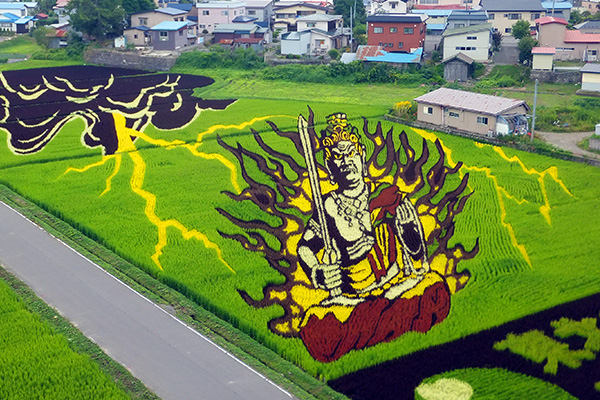
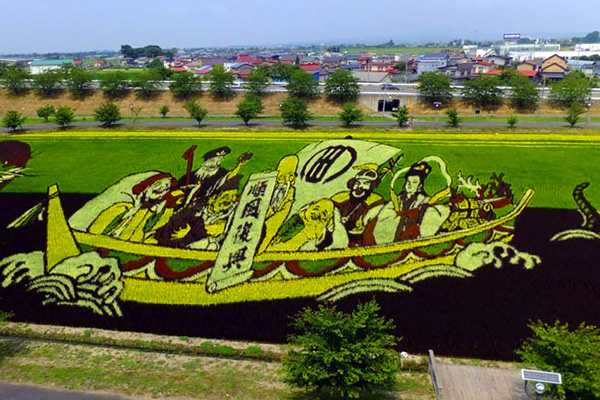
photos by flashindo.com
The picture on top is “Napoleon” in 2009. An image of Emperor of the French looks as if popping out. The second picture is “The Tale of the Bamboo Cutter” in 2011. Bright yellow field behind Princess Kaguya is expressing the shine of the moon where she is about to return. “Acala” comes the third, followed by “the Seven Lucky Gods” both from 2012. Acala was chosen for one of 2012 designs with a wish to drive off the ill fortune of the Great East Japan Earthquake, as it is recognized as a guardian deity who expel evils. Likewise, the Seven Lucky Gods was chosen to make a wish of rapid recovery of the Tohoku region.
The best time for rice paddy art viewing
Rice paddy art is open for viewing from June to early October, however it colors most brilliantly from mid-July to mid-August. In 2015, the 22nd of July was declared as the best time for rice paddy art viewing and an event was held on the day. By the way, it doesn’t mean that rice paddy arts start losing its beauty after that day. On the contrary, the artworks keep entertaining viewers by changing the colors and touch. In September, fully grown golden rice paddies add different taste on the images that used to be all greenish, then, the entire images starts showing sepia-toned colors around harvesting time. The village is expected to be busy and you must wait before you can get in the venue even on weekdays during July and August, as school holiday season and rice paddy art season come at the same time. Also, long queues are expected during obon holidays or long weekends. You are required to take a numbered ticket if over one hour waiting is expected. If you go there during the busiest time, take a ticket first, do whatever you feel like until appointed time.
Access
Rice paddy arts can be seen at 2 locations in Inakadate-mura Minamitsugaru-gun in Aomori.
Rice Paddy Art Venue 1
Location: Inakadate Village Office Eastern Rice Paddy (The village office tower)
5minutes drive from Inakadate Stations of Konan Railway
Rice Paddy Art Venue 2
Location: Michi-no-eki Inakadate Yayoi no Sato (Yayoi no Sato Observation platform)
2minutes walk from Tanbo-Art Stations of Konan Railway
30minutes walk distance between venue 1 and venue 2. The free shuttle “Taasabe” will be operated during the rice paddy art season.
【Fees】
Adult: JPY300 each venue (JPY200 to enter the village tower 6F view point)
Child: JPY100 each venue (pre-school child free)
【Opening hours】
Mid-July to end of August 8:30 – 18:00
The rest of year 9:00 – 17:00
Opens on weekends and public holidays during the rice paddy art season
See the official website for more information. The latest information with a live video is available.
We love rice!
Rice paddy art is attracting so much attention nowadays, and there are many stories to be told about it. For example, All Japan Rice Paddy Art Summit and the largest rice paddy art in Gyoda city in Saitama. It also brings more attentions from overseas countries in recent years, then, Inakadate accepts training teams from France and China. Tohoku region is located far from Tokyo but it is worth paying a visit. Don’t forget to call in Michi-no Eki and Tanbo Art Shopping Village.
